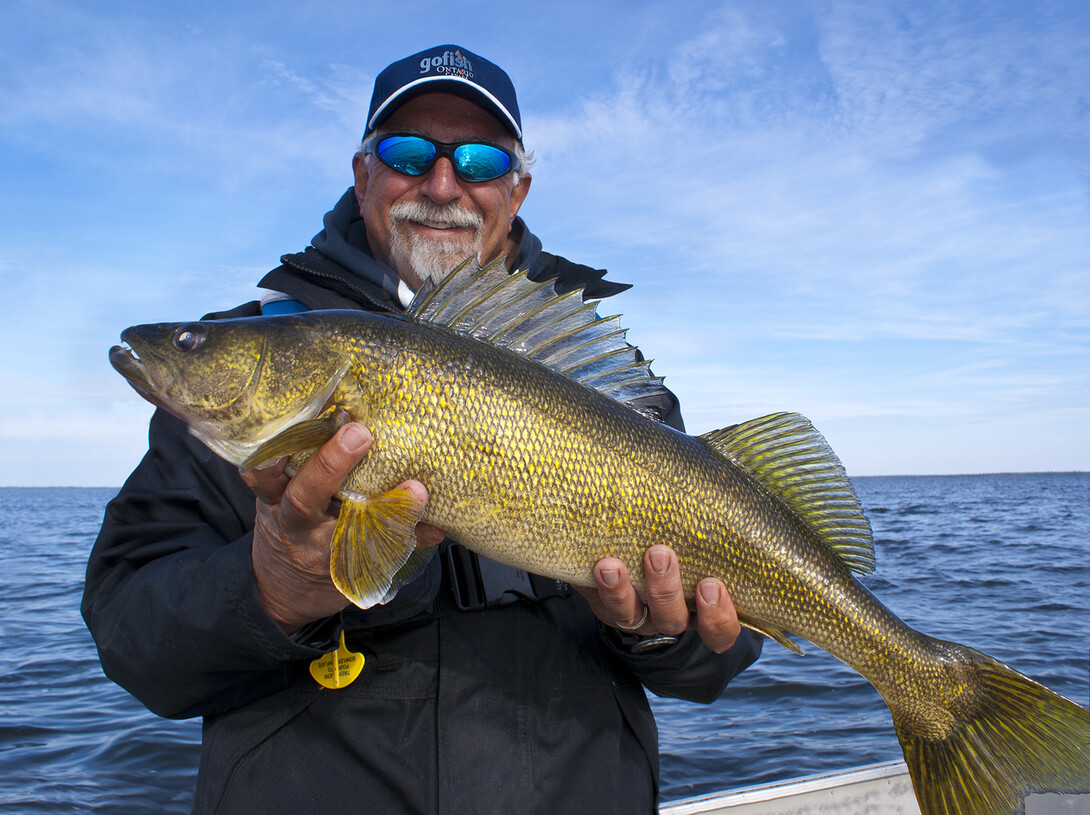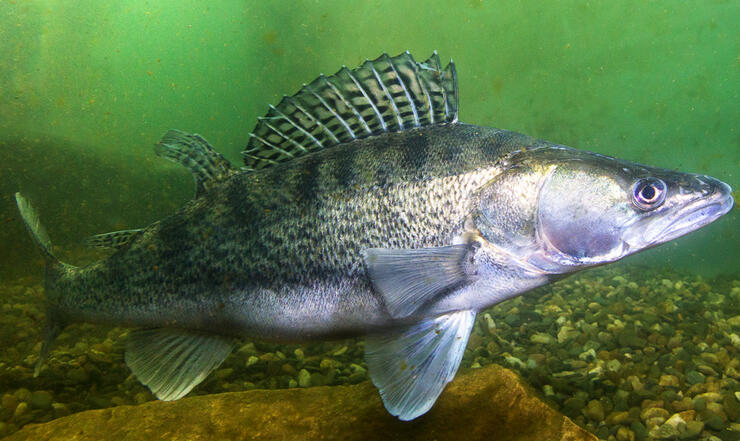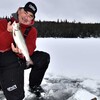
Pike and Walleye: Ontario’s One-Two Punch

When is a walleye actually a pike?
The answer is, “when it’s a pickerel”.
Confused?
Our intention is to once and for all correct one of the most egregious mistakes in the Canadian fishing world, and that is calling a walleye a pickerel. A walleye is not a pickerel—a pickerel is literally a pickerel as in a Chain Pickerel, in the Esox family of predatory fish, which by the way looks almost exactly like a pike or a muskie.

Make sure though that you do not confuse this issue with a Pike-Perch, which is actually called a European Zander.

The European Zander looks almost exactly like a Sander Vitreus, or more commonly known as, a walleye!
You got that right fishing fanatics, it really can be confusing!
We’d like to once again remind you that everyone’s health, safety and well-being needs to come first. Only travel if and when it’s safe to do so. Let’s all make the effort to prevent the spread of this nasty, horrible disease.
So, getting back to business, this Fish’n Canada article is obviously about Ontario’s most popular fish, the walleye but we’re gonna throw in the northern pike as a bonus. Let’s face it, with “northern” in your name, it gets no more Canadian!
The beauty of the walleye and the northern pike is, under normal circumstances, they reside in the same bodies of water. When one is not biting, the other can be a bonus.
THE WALLEYE
Let’s start out with the walleye. Its distribution is mind-boggling. We have caught them from a number of provinces. We have even heard of one or two being caught out east.
They can survive in deep cold lakes as well as shallow fertile lakes and everything in between.
They flourish in slow meandering rivers, and survive equally as well in fast, ripping whitewater. They truly are an adaptive species.
As well, the walleye is by far the most desired species when it comes to the iconic shore lunch. Its delicious white, flaky meat almost melts in your mouth. The entire Fish’n Canada crew loves doing walleye shoots at Ontario fishing lodges because we are guaranteed some of the best outdoor meals of the entire season.

Of course, eating fresh walleye is only a small part of this great fish’s story. It is the adventure of catching them in so many different destinations, that keeps us coming back, again and again.
From the far reaches of the north to the most southerly regions of this great area, the walleye justifiably is held in high regard.

THE NORTHERN PIKE
We will get you back to more walleye in a bit however we also want to talk to you about the northern pike. This voracious freshwater predator only takes a back seat to one fish… its cousin the muskie.
To us, that’s only because muskies can grow bigger. If it were not for that, we’d put pike and muskie at the exact same level on our “tough-guy” fish list.
The northern pike’s Canadian distribution is even greater than its little buddy the walleye. She’s a coast-to-coast deal with pike. You wanna’ talk about an adaptable creature that can be found across the nation, well the northern pike is that creature.
One thing that we have learned as anglers growing up in Ontario is that if you want to cash in on a true giant of a pike, your best chances will be to the north. Yeah, we’ve caught some big ones to the south, but by travelling to the north, for northern pike, you definitely put the odds in your favour for hooking into a behemoth!

MORE WALLEYE
Moving back to walleye, you have got to love the fact that they are a schooling fish. Yeah, the odd time you seem to catch a single fish here and there but, if you carefully scan around with your electronics after catching what you think is a loner, you may discover the school of all schools.
If you keep in your mind that walleye are in fact a schooling or grouping fish, you may unlock the code to a bunch of 'em.

FUSSY PIKE?
Often, big pike does not want to play the way they’re supposed to. They just get down-right finicky. You would think that these giants, with rows upon rows of sharp teeth, would slash and kill anything that moves. That is not always the case, even way up north…
We have often seen giant fish totally ignore any artificial presentation we throw at it. Very frustrating!!!!
But as often is the case, there is a solution as in a Quickstrike Rig under afloat.

GIANT WALLEYE LOCATIONS
Oddly enough, we have two favourite destinations in Ontario when searching for that absolute gigantic walleye of a lifetime. We say oddly because one is in the southern part of the province, while the other is over 2,000 kilometres away, in the far reaches of the north…
The first area that consistently blows our minds is Hawk Lake near Kenora Ontario. This small lake can be only accessed through Hawk Lake Lodge. This great facility is the sole reason that the walleye here is so big. Ted Putnam, the lodge owner, has implemented a 100 percent catch and release rule for walleye. While staying at the lodge and fishing Hawk Lake, all walleye must be released!

The second area that probably puts more than 10-pound plus walleye in the boat is the Bay of Quinte in Southern Ontario. This hotspot is no secret to walleye addicts, and for good reason. Big fish are caught all season long here, however, it is the fall and into the winter that produces the legendary giants that Quinte is known for.

ARE NORTHERN PIKE BETTER IN THE NORTH?
Since we live in Ontario, a question we get all the time is “just how far north in the province, do you have to travel to tie into a big northern pike?”
In our experience, you need to start in the Algoma region of Ontario and work north from there. This is a case where the further north you travel, the more abundant trophy pike will be.
As with the fall Quinte walleye, Ontario’s furthest reaches of the north are synonymous with catching giant pike. It’s that simple!

Well, there you have it, two of Ontario’s most popular fish species and as well, two that are making an impact across the entire nation.
And finally, as we have been telling you on our TV show and web articles throughout this season, if-and-when it is safe to travel to any region in this country please respect all local health and safety regulations.
We can and will get through this together.
EXTRAS
Kaby Lake Pike
To get to this fantastic fishing location, we headed north on Highway 400 to Highway 69 at Sudbury and then headed west on Highway 17 to the town of White River. We then boarded a floatplane at White River Air, which we took to Agich’s Kaby Kabins on Kaby Lake.
Hotspot
This Hotspot is a shallow, flooded weedy flat adjacent to a channel. Here’s the waypoint.
This spot is normally dry in the summer, but during my mid-spring trip, it produced a feeding frenzy that I have never experienced before. Hundreds of thousands of baitfish scoured the area and the Pike weren’t too far behind.
Since some of the extremely active fish were smashing bait on the surface, I decided to throw out Mighty Mo, a mouse-imitating topwater with fantastic action. To be honest, any bait that could be pulled through this labyrinth of weeds and brush would have caught fish—I just love the excitement of topwater hits.
Buck Lake Wilderness Lodges & Outposts
To get to this awesome Walleye lake from the south, take Highway 400 north to Highway 69. Next, take Highway 17 northwest to White River. Finally, turn right onto 631 which will take you to the Forde Air Base just outside of Hornepayne, Ontario. From there it’s a short flight to Buck Lake Lodge.
Hotspot
This Hotspot is an extending underwater rock point protruding out from the Witch’s Nose on Buck Lake. Here’s the waypoint.
Pete and Ang first investigated this spot on a nasty, rainy day and found it loaded with Northern Pike in and around the 12 feet deep mark. They knew because of the amount of Northerns around that there had to be an abundance of bait there, too. The following day they returned and tried a bit deeper and found 16-17 feet being the magic number for Walleye. By first graphing in Quickdraw Contours with the portable Garmin EchoMap, and then shading in the 16–18-foot contours with a specific colour, they could stay exactly in the Walleye zone and not venture into toothy creature water.
Recommended Articles

10 Facts About Lake of the Woods

Crawford’s Diamond in the Rough

Eating Northern Pike

Lakers of Lower Manitou: Fishing Just North of the U.S. Border

Top 5 Baits for Smallmouth and Largemouth Bass

Predicting Lake Thickness

World Class Carp

Don't Forget The Umbrella
Indian Lake Lodge
Ontario Brook Trout

Magical Montreal River Bass

Casting for Coasters

In Search of Brookies

Beaded Lures

Drive-to Ontario Lodges

The Tigers of Sunset Country

World Class Muskie at Young's Wilderness Camp

Wind, Cloud & Walleye

Exploring Turtle River


















